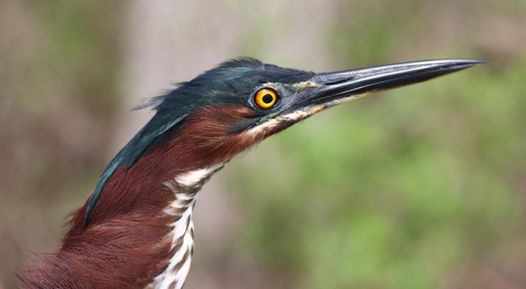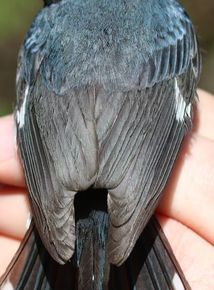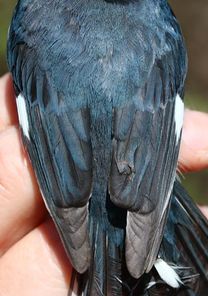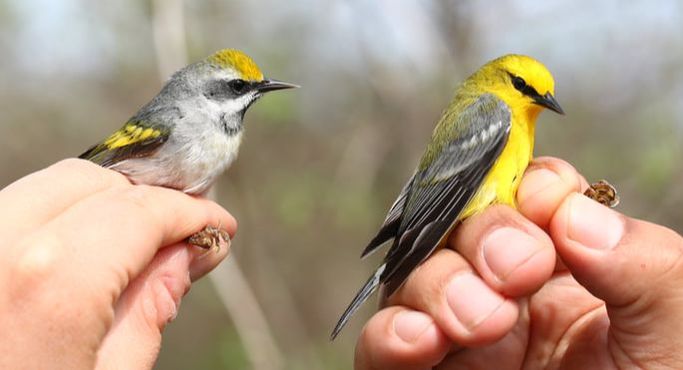Enjoying our blogs?Your support helps BSBO continue to develop and deliver educational content throughout the year.
|
|
Wow! Lots of changes have occurred in the past few weeks since our previous post, the biggest change being the shift in species dominance and abundance. After waiting for first-wave birds to arrive in late April, we saw a major confluence of birds in the first week of May with many species of warbler rolling into the marshes. The number of birds banded daily quickly rose from 100-200 to 300-500 birds, with some surprise birds such as Green Heron, Worm-eating Warbler, Cerulean Warbler, Hooded Warbler, and “Lawrence’s Warbler.” At this point in the season we sit at 31 species of warbler recorded, plus one hybrid. As great as warblers are though, let’s not forget about the non-warblers. With this great influx of birds entering the marshes, we also had spikes of White-throated Sparrow and Swainson’s Thrush with lesser numbers of Gray-cheeked Thrush, Veery, and Wood Thrush. Despite optimal conditions for major Blue Jay diurnal flights (which can number in the thousands) we have only recorded minimal BLJA movement. However, Baltimore Oriole numbers were quite high with over 20 being banded at the station in one day, coinciding with a diurnal flight tally of over 300 from a nearby Lake Erie shoreline wildlife area. Water levels in the marsh remain at a high level, with quite a few Green Heron hanging around the area. But high water has also brought about more roaming insects and has increased our capture of Tree Swallow (flying low over the water, following midge clusters). On days with high numbers of birds, we don’t usually have enough time to photograph certain species, sexes, or ages for comparisons. But, when two male Black-throated Blue Warblers of two different ages come in at the same time, we can’t pass on the opportunity to compare molt and plumages! 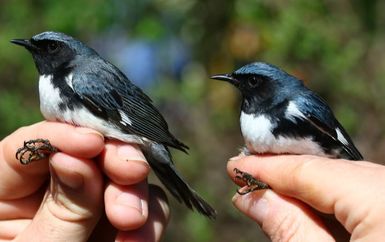 (L) SY Male BTBW, (R) ASY Male BTBW (L) SY Male BTBW, (R) ASY Male BTBW Determining male in BTBW is fairly simple as hatching-year birds will gain the distinct blue and black plumage of an adult male through their formative molt (replacing their juvenal plumage) in late summer, after they leave the nest (the same holds true for females). By next spring, last year’s hatching-year (HY) bird is now considered a second-year (SY) bird (as it is now in its second calendar year). Differentiating SY male BTBW from after-second-year (ASY) male BTBW comes down to the presence of a molt limit. But even plumage-wise, there are some slight differences. The SY bird is somewhat more matte and shows tints of green compared to the ASY, which shows a much richer, uniform blue back. Also hinting at the age difference between these two birds is the amount of white at the base of the flight feathers - being narrow and mostly limited to the primaries in the SY bird, and wide and extensive across the primaries and secondaries in the ASY bird. 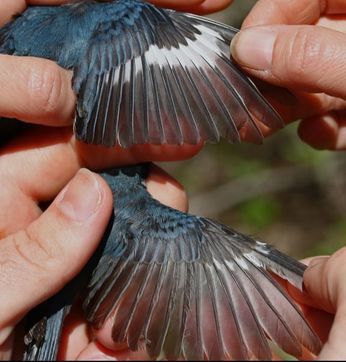 (Top) ASY Male BTBW, (Bottom) SY Male BTBW (Top) ASY Male BTBW, (Bottom) SY Male BTBW Aside from plumage appearance, the real qualifier for age determination/differentiation in these two birds is the presence of a molt limit. Last year’s HY bird would have molted twice (growing feathers in the nest, and then replacing body feathers and some wing coverts in late summer). This produces two generations of feathers, indicating a limit in the extent of molt. The ASY bird (an after-hatching-year bird the previous year) would have only undergone a pre-basic molt in late summer, producing its basic plumage and a single generation of feathers. Juvenal feathers are grown quickly and at all once in the nest, resulting in a feather of lesser quality and density that is more susceptible to the elements as compared to a basic feather. Evident in our two BTBWs, the SY bird shows juvenal primary coverts, primaries, secondaries, and tertials that are fairly dull and gray, with limited greenish edging, and contrast with the more recently replaced blue edged, dark centered greater coverts. The ASY bird’s wing shows covert and flight feathers of a single generation that all have a glossiness to them (on account of the more densely barbed feathers), dark gray to black centers, and blue edges (especially in the greater coverts and tertials). Due to this obvious difference between matte gray and dark black, and green versus blue, male Black-throated Blue Warblers are a great bird for learning about molt. This difference is so obvious it can even be viewed through the binoculars in the field! Another great capture for the station recently was that of a “Lawrence’s Warbler,” one of the two resulting hybrids between the closely related Golden-winged Warbler and Blue-winged Warbler. These two warbler species are so closely related that research suggests their entire genome is only different by 0.3%, making them 99.7% genetically alike. There have even been suggestions of lumping these two species into a single species. 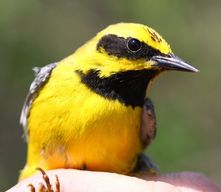 Male LAWA Male LAWA The two hybrid forms are the result of dominant versus recessive genes. The much more common hybrid (“Brewster’s Warbler”) is the result of dominant traits being passed on. While the rarer “Lawrence’s Warbler” is the result of recessive genetic traits, including the black throat of the GWWA and yellow body of the BWWA. Being able to have all three forms in the hand at once (male GWWA, female BWWA, and male LAWA, plus a female GWWA and male BWWA earlier in the morning) was a great way to compare the various traits that are passed down from each parent species and result in the Lawrence's hybrid. Over the past 50 years, the Golden-winged Warbler has seen one of the sharpest population declines of any songbird species, and is in consideration for Endangered Species classification. The expansion of the Blue-winged Warbler and hybridization with Golden-wingeds has been identified as a contributing factor to the decline in GWWA numbers. However, the primary threat (as well as to a number of other species) is habitat loss both on the breeding grounds in North America and wintering grounds in Central and South America.
0 Comments
Your comment will be posted after it is approved.
Leave a Reply. |
AuthorsRyan Jacob, Ashli Gorbet, Mark Shieldcastle ABOUT THE
|
